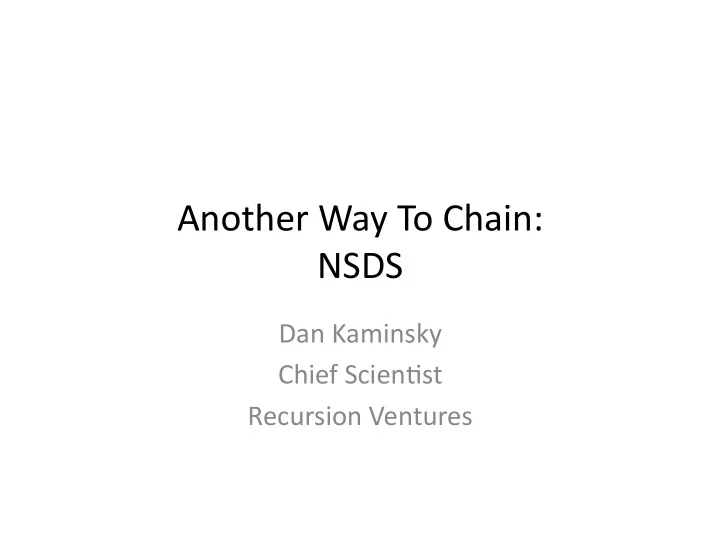

Another Way To Chain: NSDS Dan Kaminsky Chief Scien9st Recursion Ventures
The Good News • The DNS Root is being signed! – DNS has scaled magnificently for 25 years by there being one agreed upon root – DNSSEC can share in the scalability by having only one set of keys to trust • DNSSEC can actually be preJy simple now – Before: Ask a ques9on, get an answer ANer: Ask a ques9on, get an answer and a signature – Before: Ask a ques9on, get a referral ANer: Ask a ques9on, get a referral and a signature
A Slight Complexity • Referrals now contain DS records – Before: “Here is the next host to talk to.” – ANer: “Here is the next host to talk to, and here’s the key to expect.” • Really, this is very much just like normal DNS works – Everyone wants DNSSEC to be this big crazy thing. – Really, it’s just DNS with keys. That’s why it’s going to work.
Building A Chain • GeWng the key into the root was a bit tricky, but we did it – 6 hours in Culpeper, Virginia, USA • GeWng DS records from TLDs to the root appears rela9vely straigh[orward – Not that many TLDs, and there are direct rela9onships
A Temporary Issue • GeWng DS records from SLDs to TLDs is being a liJle bit of a headache – Registrar/registry split means there are no direct rela9onships – Under this split, there are two kinds of hos9ng • “Full” hos9ng – the registrar runs the authorita9ve name server • “Delegated” hos9ng – the registrar delegates the zone to the registrant’s authorita9ve name server
State of Secure Hos9ng • 1) Very few registrars will have “full” hos9ng live on July 15 th for hos9ng DNSSEC signed records – This is OK! – Really! – July 15 th is about the root being signed. This is the start of an extended process, not least of which is the engineering of much easier to deploy DNSSEC servers • What’s beJer than poli9cal pressure? Easy to deploy code!
A Temporary Condi9on • 2) Only a few registrars will be ready, on July 15 th , to absorb the DS records of their delegated customers – Only ~20% of the Alexa 10,000 will be able to push DS records. 80% will not. – This will get be2er over 6me. – It is, however, a real impediment for early adopters.
How Technologies Grow • Early Adopters are key – Code does not come out of nowhere. – The game is to provide this rela9vely small community a rela9vely vast fron9er for innova9on – There is a lot of ground to cover with DNSSEC – When is it ready for people to start playing with it?
The Date • July 15 th , 2010. – Ready or not, here they come. – One way or another, we should be ready for them. – We just did a tremendous amount of very good work! And we, like it or not, are going to get a tremendous amount of press for it. – Is it possible for us to make sure early adopters can s6ll par6cipate, even if their par6cular registrar hasn’t upgraded yet?
Introducing NSDS • Consider the NS Name – Always supplied by the user – Always opaque to the registrar – Always submiJed to the registry via a secure path (EPP) • This path respects the registrant/registrar rela9onship! • Consider the DS record – DS records are not complicated – Three ints and a hash string. • A DS record can pre2y easily fit into a NS Name.
Bits and Bytes • nsds‐v1‐60485‐5‐2‐ D4B7D520E7BB5F0F67674A0CCEB1E3E0614B93.nsd s‐C4F9E99B8383F6A1E4469DA50A.domain.com – No label allowed to exceed 48 bytes – Total length well below 256 character limit – Versioning allows upgrade – Metadata (60485, 5, 2) only present on leNmost label – This is essen9ally a port to DNSSEC of one of Dan Bernstein’s ideas for DNSCurve
The General Idea • The general idea – A specially formaJed NS Name is sent through the registrar, through EPP, to the registry – The registry detects the specially formaJed name, and expands it inline as if there was a DS record in the submission
The Perfect Is The Enemy Of The Good • This isn’t the most perfect thing that has ever been proposed – That’s OK. The Internet doesn’t really run on the most perfect technologies, does it? • Token Ring • ATM
S9ll Need To Work With Registrars • NSDS doesn’t at all obviate the need to work with registrars – We s9ll need to work towards full hosters signing all their records – First class support for DS transfer is beJer than a failsafe – Easy to sunset the failsafe at the (now fully compliant) registrar
This is really easy to implement. • There is one moving part – The registry • There is one point of code modifica9on – The EPP parser • There is very liJle code to write – There are hard things to do in this world – Wri9ng a translator between NSDS and DS is not one of them. • Three ints and a hash string. • We get 100% feature compliance – The output is fully func9onal – The input is fully secure
BoJom Line • A choice – We can go live for 20% of early adopters – We can go live for 100% of early adopters • No maJer what, the signing of the root is a revolu9on for opening DNSSEC up for business – This small bit of code would win us 5x the support on Day One – Over the next year, many things will happen to make DNSSEC more exci9ng and less expensive to deploy • The more early adopters, the faster this happens – We can have 5x the early adopters! But we need this small change.
Recommend
More recommend